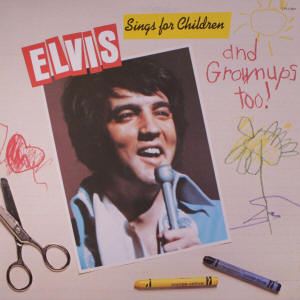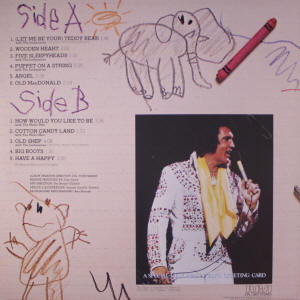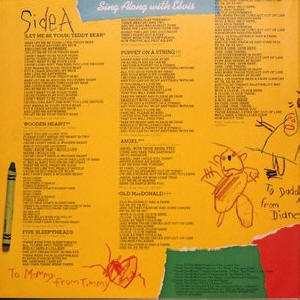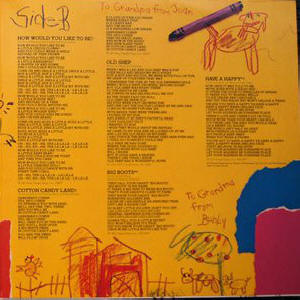



For the first anniversary of the king's
demise RCA released an album called "Elvis Sings
For Children...And Grownups Too!". In August
1978 the record entered Billboard's "Top LPs
Chart". It stayed for eleven weeks, but never
made it past number 130. On the "Hot Country LPs
Chart" the release feared much better, here it
had a run of sixteen weeks and peaked at number
5. In 2011 the RIAA honored the domestic sales
with a Gold Award, worldwide "Elvis Sings For
Children...And Grown Ups, Too!" may have sold
between a million and one and a half million
copies. So today the release would have
generated somewhat between 150 million and 225
million paid streams of the complete album or
between 1.2 billion and 1.8 million paid streams
of individual tracks.
Since all tracks are available elsewhere "Elvis Sings For Children...And Grown
Ups, Too!" cannot be found on the streaming
platforms.
Even though it just holds a single
longplayer, RCA produced a fold-out cover.
Inside we can find the lyrics of the songs, so
we and our children can sing along to the king.
The front cover features a photo of Elvis, which
was shot in January or February 1970 in Las
Vegas. On the back there is a smaller picture
from the singer's 1973 summer tour. As a special
gimmick the first pressing of "Elvis Sings For
Children...And Grownups, Too!" the photo wasn't
simply printed on the sleeve, but was a
postcard, that could be removed. The cover
includes "children's drawings" and messages like
"To mommy from Timmy" or "To grandpa from Joan".
This is a little inside-joke from Joan Deary
(the producer of the album) and Tim Byron (the
designer of the packaging).
As the title suggests, the album is a
compilation of children's songs or tunes, which
are or could be aimed at children. One exception aside, all
the songs were originally featured in movies,
that often included children as popular figures.
Originally Colonel Parker had brought up the
idea for such an album in late 1975, but was
rejected by RCA at the time. With the demise of
the singer the situation had changed and the
project was realized. Why the management of the
label thought, the first anniversary of Elvis'
death might be the best time to release a
compilation of children's songs, is not known. I
certainly had preferred a boxed set like "Elvis
Aron Presley" (1980) or "A Golden Celebration"
(1985). Nevertheless the idea behind "Elvis
Sings For Children...And Grown Ups, Too!" was
original and the project was executed very well.
RCA obviously spent some time and thought on
this release.
Teddy Bear
The singer begs his loved one to be
her Teddy Bear. Tigers are too rough and lions
are not kind enough. For a performer, who was
sold as a rebel and even the king of the wicked
rock'n'roll music, lyrics like that were
embarrassing. But the girls loved it and "Teddy
Bear" became an evergreen. It's not really
a children's song, but the lyrics could be
construed as being sung from a mother or father
to a kid. In the 1970s Elvis
mostly performed it in a medley with "Don't Be
Cruel". Live recordings can be found on "Elvis
As Recorded At Madison Square Garden" (1972) and
"Elvis In Concert" (1977). RCA
Victor also released the studio recording on the
album "Loving You" (1957), the extended player
"Loving You - Volume 1" (1957) and on
the boxed set "Worldwide 50 Gold Award Hits -
Volume 1" (1970). To promote "Elvis Sings
For Children...And Grownups Too!", RCA released
the single "Puppet On A String" / "Teddy Bear"
in early August 1978. The record didn't chart on
Billboard's "Hot 100", but was listed on their
"Hot Country Singles Chart" for four weeks,
peaking at number 78. To make it short: It
wasn't a success at all.
Wooden Heart
In 1827 Friedrich Silcher adapted the German
folk song "Muss I Denn, Muss I Denn Zum
Staedtele Hinaus", 133 years later Fred Wise,
Ben Weisman, Kay Twomey and Bert Kaempfert
turned it into "Wooden Heart". Elvis recorded it
on April 28, 1960 within four takes. Strangely
though the writers didn't use the original
German lyrics, but created new ones. They give
the impression to have been translated with a
mediocre software (just like my homepage). This
one also isn't a children's song, but it's a
nice sing-along, which often was intoned in
kindergardens and schools in the old days. In
Europe, Asia and South Africa RCA Victor
released "Wooden Heart" on a single and sold
more than 2 million copies in Germany alone!
However, in the US the label stuck to the
release on the album and left the number one hit
to Joe Dowell. However in 1964 the track
appeared on the flipside of "Blue Christmas" and
a year later it could be found on the b-side of
"Puppet On A String".
Five Sleepy Heads
Sid
Tepper and Roy C. Bennet based their song on the
"Wiegenlied" by Johannes Brahms. It was
written for a scene of the movie Speedway, in which Steve (Elvis) puts
five children to bed. Because MGM cut this
particular scene from the film, RCA Victor
labeled the track as "bonus song". The king
recorded "Five Sleepy Heads" on June 20, 1967
within three takes. Brahms' original as
well as the re-writing is a song to put children
to sleep. So it fits here very well.
Puppet On A String
The ballad
was written by Sid Tepper and Roy C. Bennet and
recorded by Elvis on June 10, 1964 within 11
takes. The narrator is in love and completely
under the spell of his beloved one. Of course it
was meant to be sung by one lover to another,
but it also could be warbled to a child to tell
it, that it's ones everything. It's a good
song, without doubt the best one on the "Girl
Happy" soundtrack. Therefore it was relesed
on a single, combined with "Wooden Heart" from
the film "GI Blues". In 1971 RCA Victor also
released the track on the boxed set "The Other
Sides - Worldwide Gold Award Hits Volume 2".
Angel
Elvis needed seven takes for this
beautiful ballad,
which was written by Sid Tepper and Roy C.
Bennett. It was taped on July 2, 1962 for the
movie "Follow That Dream" and first appeared on
the accordant soundtrack ep. In 1971 RCA's
budget label CAMDEN also put it on an album
named "C'mon Everybody". Once again
this is a song about the beauty of a person of
sexual interest, but one might interpret it
innocently to be a tune about a child's beauty,
too.
Old Mac Donald
The children's song is based on a title from the
opera "The Kingdom Of Birds", written in 1720.
Later versions were "The Farm Yard, Or The Merry
Green Fields" (1908), Ohio (Old Macdougal Had A
Farm) (1917) and "Old Missouri" (1922). The
oldest known recording was made in 1925 by The
Sam Patterson Trio. Here it was already named
"Old Mac Donald Had A Farm". Later the song was
also recorded by Frank Sinatra, Ella Fitzgerald
or Elvis Presley. He did it on June 29, 1966 at
the MGM Soundstage. The master was a combination
of take 3 (rhythm track), take 7 (vocal track)
and a vocal repair recorded on June 30th. The
tune was re-written by Randy Starr, which
legally created a new song that could be
published on its own. Elvis recorded it for his
movie "Double Trouble", CAMDEN re-released "Old Mac
Donald" in 1972 on the budget album "Elvis Sings
Hits From His Movies - Volume 1"..
How Would You Like To Be
In the movie "It Happened At The World's Fair"
the tune is sung by
Elvis and Vicky Tiu, but on the album we just
hear the voice of Mr. Presley. For whatever
reason RCA thought it was a good idea to couple
a Christmas song with this one and released it
on the b-side of "If Every Day Was Like
Christmas" in 1966. It was also included on the
CAMDEN release "Elvis Sings Hits From His Movies
- Volume 1" (1972). The king needed six takes
for this song when he recorded it on September
22, 1962. The composers are Ben Raleigh and Mark
Barkan.
Cotton Candy LandThis is
supposed to be a children's song, but it has a
somewhat creepy undertone. I can imagine this
song in a thriller to accentuate a scene of a
infanticide. However, it wasn't meant this way
by Ruth Batchelor and Bob Roberts. Elvis
recorded "Cotton Candy Land" on September 22nd
and needed five attempts to reach a satisfactory
take. This one is also from "It Happened At The
World's Fair".
Old ShepRCA released the
song on "Elvis", the second longplayer of the
singer.
At the time "Old Shep" must have been a real
surprise, because nobody expected a sad ballad
about a boy and his dog from somebody, who was
said to be the king of rock'n'roll. In fact
Elvis loved "Old Shep" and sang this song since
his childhood days. I like the track very much,
because it's one of the very few ballads, that
Elvis sang well at the time. In the 1950s he was
really good at uptempo songs, but he simply
lacked the technique to perform the slow tunes
well. On September 2, 1956 the king recorded
five takes of "Old Shep", but finally approved
his first attempt for release. Because of a
mistake some pressings of "Elvis" include take 5
of the song. Today these versions of the album
are quite expensive. RCA Victor also released
"Old Shep" on the ep "Elvis - Volume 2" (1956),
CAMDEN included the sad ballad on the budget lp
"Separate Ways" (1972). The song was written by
Red Foley, who was also the first to release it.
Big Boots
In the movie "GI Blues" Tulsa (Elvis) sings the baby
of one of his army buddies to sleep, in real
life "Big Boots" caused the king some trouble.
On April 8, 1960 he recorded four takes of the
slow version, we are hearing on the album. After
that he taped seven takes of a fast version. On
May 6th there were two takes in medium tempo as
well as six takes, four insert-takes and five
composite-takes of the slow version. The final
master was spliced of take 4 (April 28th),
insert-take 4 (May 6th) and composite-take 3
(May 6th). In general the song by Sid Wayne and
Sherman Edwards isn't bad, but withouth the
accordant movie scene it appears somewhat
strange.
Have A Happy
The album ends with a track from "Change
Of Habit". It was recorded at Decca
Universal Studio in Hollywood/California on March 6, 1969. Elvis needed seven
takes to reach a satisfactory result. The song
was written by Ben Weisman and Buddy Kaye and
can be compared to the many mediocre movie
ballads of the mid-sixties. The tune was
released in 1970 on CAMDEN's budget album "Let's
Be Friends".
Verdict
Even though a retrospective or a
collection of outtakes might have been the
better choice for the first anniversary of
the king's death, it cannot be denied that
this collection of children's songs puts the
focus on an almost unknown part of the
singer's work. Besides that, RCA obviously
spent some time and money to come up with an
elaborate product.

(C) RCA Victor
![]()



